#olmsted point
Explore tagged Tumblr posts
Text

Alpine Lake
What do you think about my pic?
#Tenaya Lake#Yosemite National Park#Olmsted Point#Sierra Nevada#mountains#USA#summer 2022#landscape#countryside#Tioga Pass Road#woods#forest#flora#original photography#California#travel#vacation#photo of the day#What do you think about my pic?#granite#tourist attraction#landmark
10 notes
·
View notes
Text
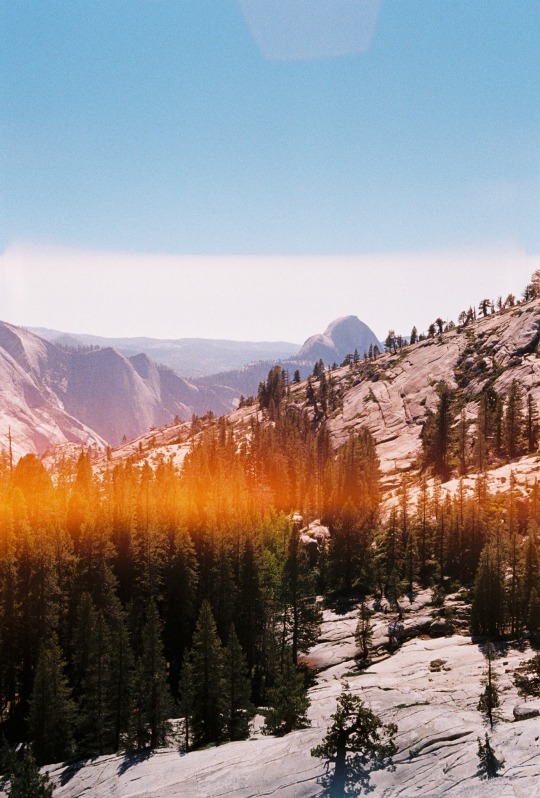
Half Dome from Olmsted Point
#holy cannoli these rolls are amazing#my film#35mm film#film photography#stay broke shoot film#35mm#film is not dead#canon ae1#california#Yosemite#Yosemite National park#half dome#tioga rd#Olmsted point#photographers on tumblr#light leaks
27 notes
·
View notes
Text
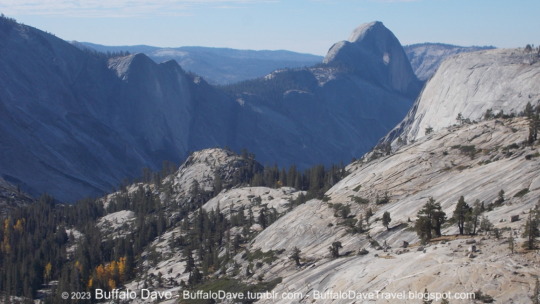
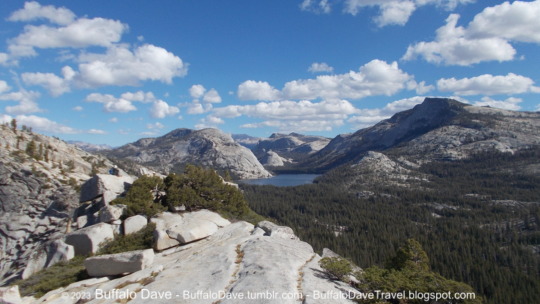



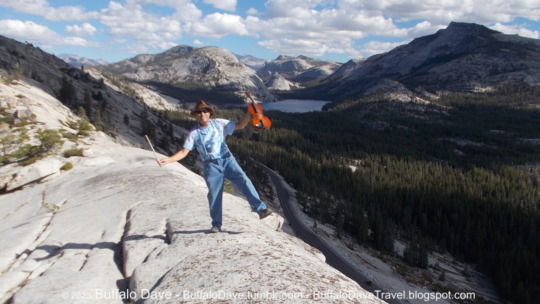
Yosemite National Park on top of dome above Olmsted Point - looking down to Half Dome and looking down toward Tenaya Lake
Buffalo Dave is fiddling!
pictures taken October 16 through 28 2023
1 note
·
View note
Text

Tree in rock, Olmsted Point, Yosemite National Park - by Dale Johnson (1944), American
76 notes
·
View notes
Text
Dancers You Might Know That Competed Against ALDC (Dance Moms) - Season 4
Season 4 Episode 1 Sheer Talent Wheeling 2013
New England Dance Centers attended the competition (Jade Clouds mothers studio, select team)
New England Dance Centers group "The Forgotten Children" comes in 1st ahead of ALDC "Girls Night Out"
Abby Lee Miller is listed as the choreographer for "Girls Night Out", even though Molly long choreographed the routine
Season 4 Episode 2 Believe Columbus 2013
Tillie Glatz (Studio Bleu) beats Kendall (5th) and Chloe (2nd) with her solo "If I Had My Way"
other well known studios: Studio Bleu
Season 4 Episode Special Dancers Care Foundation Benefit Competition Atlantic City 2013
Season 4 Episode 4 In10sity Orlando 2013
JoJo Siwa performs a solo ("Call Me Back") at this competition and comes in 3rd behind Maddie (1st)
Season 4 Episode 4 Dance Troupe Roanoke 2013
ALDC and CADC group dances are the only two dances competing in that category, ALDC scores 3.2 points higher than CADC
Season 4 Episode 5 Masters of Dance Arts Atlanta 2013
competition created just for dance moms
Season 4 Episode 6 Onstage America Voorhees 2013
Michelle Quiner (North Jersey Sch. o. D. A.) competes in the Advanced Teen Division and places 1st with her solo "Sunrise"
other well known studios: Jamie's Dance Odyssey, North Jersey School of Dance Arts
Season 4 Episode 7 Sheer Talent Bronx 2013
Michelle Quiner (North Jersey Sch. o. D. A) comes in 1st in Teen Solo with her solo "Sunrise", ahead of Brooke (4th)
other well known studios: North Jersey School of Dance Arts
Season 4 Episode 8 Fierce Dance Competition Woodbridge 2013
Kaeli Ware performs for ALDC, comes in 3rd with "The Sparrow"
Kamryn Beckn and Chloe Smith also compete for ALDC, however their solos don't place as the competition has all dances of one age division compete against each other for a mere Top 3
Season 4 Episode 9 Masters of Dance Arts Fort Wayne 2013
competition created just for dance moms
Season 4 Episode 10 Masters of Dance Arts Detroit 2013
Ava Cota competes under BDA and places 3rd in Junior Solo with "Read All About It", she places behind Maddie (1st) and ahead of Kendall (9th)
competition created just for dance moms
Season 4 Episode 11 In10sity Toledo 2014
competition created just for dance moms
Season 4 Episode 12 World Class Talent Experience Rockville 2014
Season 4 Episode 13 World Class Talent Experience Canton 2014
Season 4 Episode 14 Dance USA Columbus 2014
Season 4 Episode 15 Masters of Dance Arts Buffalo 2014
competition created just for dance moms
Season 4 Episode 16 Energy NDC Youngstown 2014
competition created just for dance moms
Season 4 Episode 21 Sheer Talent Wheeling 2014
competition created just for dance moms
Season 4 Episode 22 In10sity Olmsted Falls 2014
competition created just for dance moms
Season 4 Episode 23 POWERHOUSE Front Royal 2014
competition created just for dance moms
Season 4 Episode 24 Imagine Woodbridge 2014
other well known studios: Studio Bleu
Season 4 Episode 25 Believe Woodbridge 2014
Season 4 Episode 26 Energy NDC Watersford 2014
competition created just for dance moms
Season 4 Episode 27 Sheer Talent Wayne 2014
competition created just for dance moms
Season 4 Episode 28 DanceKidsUSA Orlando 2014
Season 4 Episode 31 In10sity Calabasas 2014
Ava Cota competes as an independent and comes in 3rd in Junior Solo, and 10th overall, behind Kendall (3rd Jr, 9th Overall), Kamryn (6th Tn, 7th Overall) and Chloe (5th Tn, 6th Overall)
other well known studios: San Diego Dance Center
8 notes
·
View notes
Text
The New Republic
Opinion Trump Insists He’s “Brilliant” in Interview That Goes Off the Rails
Edith Olmsted Tue, February 11, 2025 at 8:48 AM CST Donald Trump is continuing to pretend that being a blathering fool is impressive.
During an interview with Fox News’s Bret Baier, which aired in full Monday evening, Trump went on several unwieldy tangents, skirting around answering simple softball questions that the interviewer offered on a silver platter.
At one point, in the middle of a thought, Trump diverted his answer to congratulate himself on just how obtuse he was being. [ i am liking this writer ] “And you know, let’s go back over there, because I’m the weaver,” Trump said, abruptly switching topics. “I’m the great weaver, you know that right? OK? I’m the great weaver.”
“Trust me,” Baier replied. “I get it.” The Fox News host put one hand up as if to physically stop the president from getting off track, but Trump chugged along like a runaway train.
“Somebody said, ‘Oh, he rambles,’ no, no. Only the fake news says that,” Trump said. “To weave you have to be brilliant; to ramble you don’t have to be brilliant at all.” [ well, we already know that. ]
A smiling Baier interjected again, gently corralling the ranting president back toward coherence. “I’ll just get back in the weave there. I have to get you back in,” he urged. “But I like the weave because it covers a lot of territory, and it covers it much more quickly,” Trump continued, before segueing back into a point about Israel. Over the course of the chaotic interview, Trump tactlessly sidestepped a question about whether he was actually capable of lowering inflation, and went way off course when responding to a softball question about uniting the country. Trump also took the opportunity to throw Vice President JD Vance so far under the bus you could hear the bones crunch. [ yasss. the bones crunch. ]
2 notes
·
View notes
Text
"Thinking he [Pontius Pilate] was merely pointing to a man from Nazareth, he failed to recognize that he was pointing to God made man- the Word made flesh, Jesus of Nazareth - who at once is fully God and fully man, and the perfection of masculinity. Every moment of His life on earth is a revelation of the mystery of what it means to be man - that is, to be fully human and also, the model of masculinity. Nowhere else can we find the fullness of masculinity as we do in the Son of God. Only in Jesus Christ can we find the highest display of masculine virtue and strength that we need in our personal lives and in society itself."
-Bishop Thomas J Olmsted, Manual For Men
#catholic#catholicism#christian#christianity#jesus#masculinity#manliness#christian masculinity#catholic masculinity
4 notes
·
View notes
Text
when you get to be a certain age, and youve suffered enough hardships, well, at some point you start to understand what frederick law olmsted was talking about.
3 notes
·
View notes
Text
BIPOC autistic people, content creators, blogs, and pages!
Okay...
This post was one that I was unsure how to write. I'm white and I am very aware of my privilege.
I wanted today's post to highlight and center the voices of autistic BIPOC individuals and honestly, I couldn't just talk about a few. I wanted to put as many names out here for people to follow.
For those who want to follow and learn and for those who need to find these wonderful people in their community.
When researching and working on my list, I came across a post made by Autistic, Typing in 2019 as they had made a list of Autistic Black/ Indigenous/ People of Color & Latinx Advocates to follow.
So today's post is a link to this amazing individual's link, https://www.faceook.com/share/p/VMWG2wURiVWuTP2r/
This link contains all their hard work and emotional labour, a comments section FILLED with people adding others or themselves to the list, as well as a google doc form to add/ edit/ remove autistic creators. So please, if you are one, go fill it out and have yourself added to the list!
Below are some people/ creators/ pages that I thought should be mentioned. I tried to just add the ones I didn’t see listed, but I know there is overlap and tried to point those ones out.
And PLEASE send me any others! I want to follow as many as I can.
Famous People
Anita Cameron- one of the original disability rights activists of the US.
Angela Weddle- artist (mentioned on the post)
Dr. Sarai Pahla- MD and medical translator
Dr. Angel Durr- CEO of DataReady DFW
Burnett Grant- senior lab tech at ZoomEssence Inc
Bernard Grant- Phd in English
Stephan Wiltshire- architectural artist
Lauraen-Rocelle Fernandez- Founder of Mask Off
Michael Buckholtz- music producer for acts such as MC Hammer
Jade Logan- comic artist
Elise Nicole Bowen- music composer who can be found on spotify
Avery Ahmer- tik tok influencer who talks about autism
Kayla Smith- Black Autistic Disability Rights Advocate and creator of #AutisticBlackPride
Kris Young- writer and blogger at Black Neuroqueer Punk (mentioned on the post)
Jackie Pilgrim- Board of NAMI
Armani Williams- professional Nascar driver
Morenike Giwa Onaiwu- advocate and public speaker co-edited All The Weight of Our Dreams and Sincerely Your Autistic Child (mentioned on the post)
Michael Fuller- music prodigy
Melissa Simmons- founder of MisTaught and the creator of Black History Month for Dummies & White Teachers (mentioned on the post)
Lamar Hardwick- the Autism Pastor. Writer and advocate (mentioned on the post)
Kambel Smith- artist known for complex architecture sculptures
Ronaldo Bryd- artist
Ikea “Syance” Wilson- artist and musician
Kris McElroy- writer, artist, and advocate
Talia Grant- first female actress who is autistic to land a mainstream role on British television
Kalin Bennett- first autistic person to receive a division 1 scholarship to play basketball
Tom Wiggins- former enslaved person who was an amazing musician
John Howard- martial arts competitor/ MMA fighter
Morgan Harper Nichols- storyteller and influencer
Questlove- musician and songwriter and collaborator for Disney Jr “Rise Up, Sing Out”
Lois Curtis- artist and plaintiff in the 1999 Olmsted Supreme Court Decision
Tyla Grant- found of Black and Neurodivergent (BAND) and host of the one percent podcast
Nik Sanchez- actor
Benjamin Banneker- naturalist and mathmetician
Talisha Johnson- writer and director of Too Autistic for Black
Joshua Beckford- child prodigy and youngest person to be admitted to Oxford at 6
Breanna Cook- Paralympic athlete
Creators
Marcela Collier @highimpactclub
Black Neurodiversity @blackneurodiversity
Autistic Black Woman @autisticblackwoman
Ryse @teachingwithmxt
Caro @disrupt_yuh_feed
Jessie @momma_lips
Nadia @autisticblackgirl
Kayla Smith @BeingKaylaSmith
Tiffany Joseph @nigh.functioning.autism (mentioned on the post)
Tiffany Hammond @fidgets.and.fries (mentioned on the post)
Lauren Melissa Ellzey @autienelle
La Fille Dani @myneurotype
Tim Boy @blackinfinityking (mentioned on the post under previous tag name @BlackAutisticKing)
Raven Derose @confidencewithrae
Danielle @zelue
Ahylaysia @ahlaysia
Rosalie Babette @theautisticgiraffe
Dr. Kofi @autisticallykofi
Jonteugbeye @jonteugbeye
Nia Patterson @thefriendineverwanted
Anansi @dreadfulrebel4x
Gianna Rose @usagi_rose_universe
M’Nda @melaninmaven97
Lina’s brain @ndwellness
Pages
The Activistic Autistic
The Art of Autism
Fidgets and Fries (mentioned on the post)
Not Your Mama’s Autism
The Kisha Project
Autism in Black
Neurodivergent Rebel
Black Neuroqueer Punk (mentioned on the post)
The Color of Autism
Sincerely Your Autistic Child
NeuroClastic- PLEASE pass along their post A Letter to Black and Indigenous Autistic Teens
Autistic, Typing- They have the amazing list of Autistic BIPOC Advocates here!!
Morenike GO
Black Autistic Lives Matter
Autistic People of Color Fund
Autistic People Of Color, Indigenous People, and Mixed-Race People - this is a private FB group highly recommended I can not comment on it
Neurodiverent Black Women- another private FB group recommended but I can not comment on it
Other Amazing Neurodiverse People
Simone Biles- olympic gymnast ad most decorated gymnast with 32 metals
Amada Gorman- youngest inaugural poet in US History
Clary Chambers- founder and CEO of SparkClarity
Solange Knowles- singer and actress
Harry Belafonte- singer, songwriter, actor. First Black person to win an Emmy.
Maya Angelou- poet and activist. Write “I know why the caged bird sings” and the poem “On the Pulse of the Morning” that was read at the 1993 presidential inauguration
Danny Glover- actor, director, activist. Prominent roles in Lethal Weapon, The Color Purple, and Angels in the Outfield
Octavia Spencer- actress, author, producer. Worked on The Help.
Brandon Marshall- former NFL player
Kelly Rowland- singer, songwriter, actress and member of Destiny’s Child
Jumaane Williams- politician and activist in New York City
Magic Johnson- former professional basketball player and one of the greatest 50 players of NBA
Clarence Page- journalist who has won a Pulitzer Prize
Mohammed Ali- professional boxer and activist
Black Girl, Lost Keys
Tumi Sotire @TheBlackDyspraxic
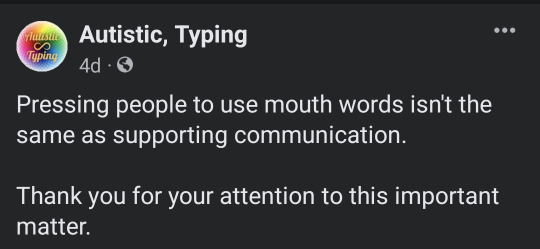
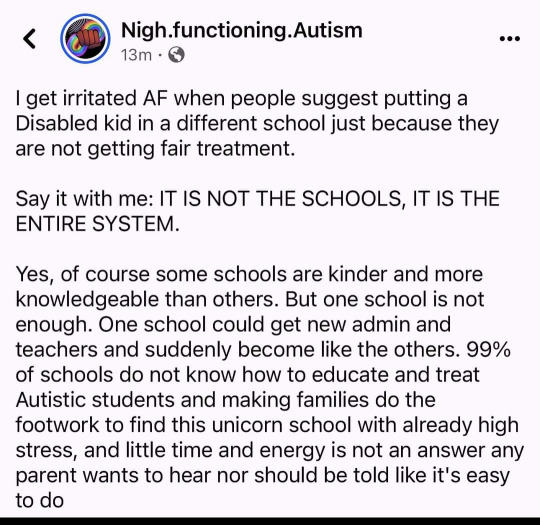


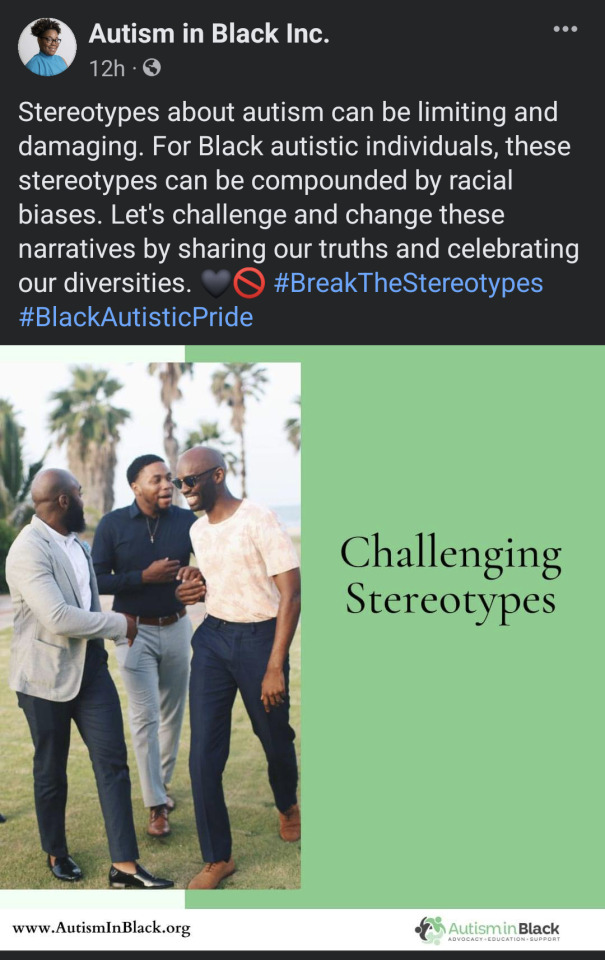
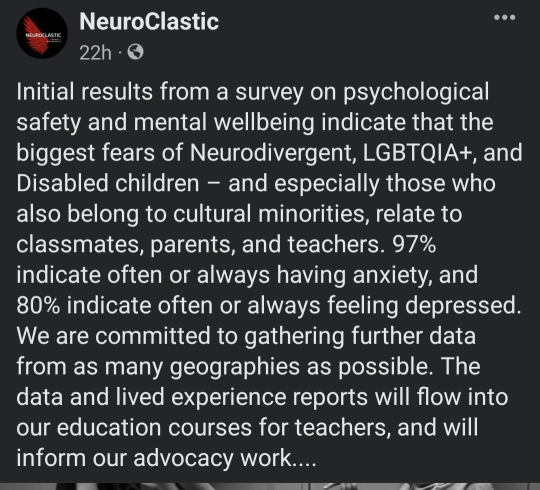
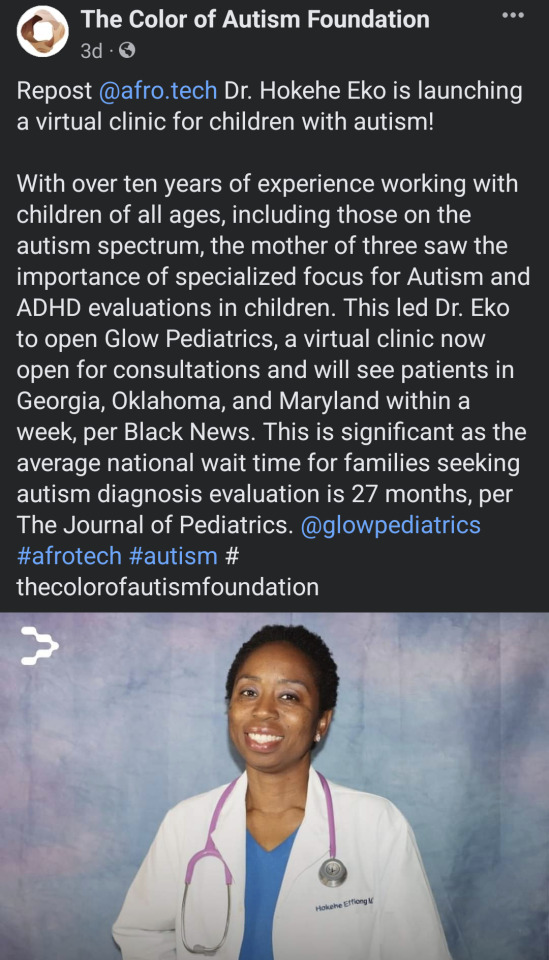
#audhd#autistic adult#actually audhd#autistic pride#autism acceptence month#autism#autism acceptance#asd#autistic
6 notes
·
View notes
Text
thoughts of the day: 5/23
What I've mostly been ruminating on this week is ideas of Euro-American versus Indigenous thoughts around land use.
This week I visited Hirundo Wildlife Refuge in Western Old Town. The refuge has done its due diligence in recognizing this as a place where Wabanaki historically lived and gathered, as far back as 5,000 years ago. It is registered in the National Register of Historic Places by the U.S. Department of the Interior. In the 1970s, the University of Maine did an archaeological dig at the site, and the land still bears the marks of those digs.
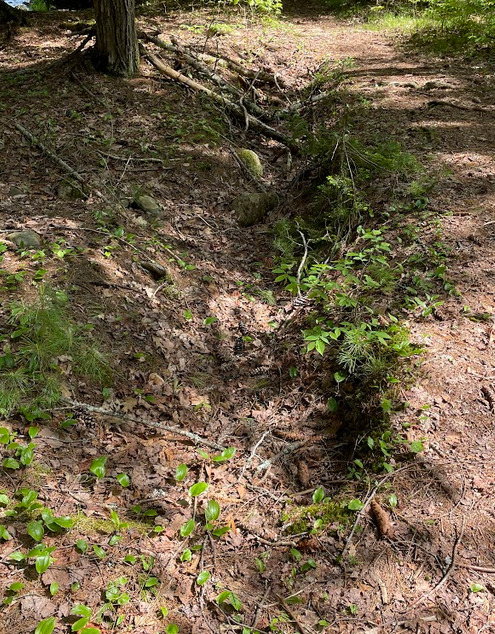
On one hand, the recognition of this historical significance is good, but it also continues to place the importance of this place firmly in the past. "This was a place for the Wabanaki, but now it is a wildlife refuge, and isn't it so nice that we're taking care of it and keeping it safe from human hands?"
The removal of humans from the ecosystem seems to be a distinctly European idea; In their eyes, the relationship between humans and the environment is necessarily destructive and exploitative rather than symbiotic. This leads to the popular idea among disillusioned, often white academics that the world would be better off without humans in it.
Robin Wall Kimmerer explores this idea further in her 2013 novel "Braiding Sweetgrass", a collection of essays that marries Indigenous knowledge and Western science beautifully. I believe that each have their place, but in order to best learn, we need to utilize Two Eyed Seeing (interestingly, an idea that was first brought forward and named by two Mik'maq (Wabanaki) elders).
To my point.
In the first chapter of Kimmerer's book, "Skywoman Falling", she compares Indigenous and Western creation stories. Skywoman's relationship between the animals and plants (non-human relatives, as my mentor often says) is symbiotic and serves to better the lives of both.
Meanwhile, the Christian creation story and relationship Adam and Eve have with their environment is far less reciprocal. They are shunned from their comfortable home and left to suffer in the world, and must take what they can get to survive. I think this lies at the center of much of Christian (and thus, Western) ideology--That we must take.
Reciprocity is so very important to Indigenous lifeways and environmentalism. I return to ideas of place and how this centers around my visit to Hirundo, and the readings I did this week (Specifically, exploring Samantha Senda-Cook's piece, Materializing Tensions: How Maps and Trails Mediate Nature). The public often tends to view National Parks and wildlife reserves as being raw nature, but these too are shaped by human hands to cater to a certain demographic, to fulfill ideas of what nature "should" look like. But they are managed, and their trails managed to a degree. As Senda-Cook puts it:
Like Niagara Falls, some landscapes that have been physically altered are perceived as not constructed, as ‘‘natural.’’ For example, Olmsted (1863/1990) best known for designing New York’s Central Park was concerned with presenting nature to at once cultivate visitors’ feelings and mask such cultivation. He planned every aspect of a landscape, including details such as flower head size and stem length, to communicate particular messages and evoke particular emotions. La Pierre (1997) described how the National Park Service (NPS) has started to include human artifacts such as roads in preservation efforts because they have become as important to the landscape as the land itself. She explained that visitors love the views from the road in Acadia National Park in Maine. ‘‘What visitors may not realize is that John D. Rockefeller, Frederick Law Olmsted, Jr., and others deliberately manipulated nature to achieve those views’’ (p. 32). Finally, as Spirn (1996) contended, efforts to construct landscapes such as the ones enacted by Olmsted remain largely invisible to park visitors. She states, ‘‘Few people now recognize [Central Park, Niagara Falls, and Yosemite] as built landscapes’’ (p. 91). These places carry a unique kind of material rhetoric that appears natural. (Senda-Cook, pg. 357.)
I've also ruminated on how National Parks have served to block cultural access to traditional hunting grounds, fisheries, and places were medicines may be gathered, such as in Acadia National Park. Acadia is my next destination in exploring my thoughts and research. I will explore this idea more in my next post.
3 notes
·
View notes
Text
Police in Ohio have released a chilling surveillance video showing a suspect wandering around a shopping center with a knife in the moments leading up to the fatal stabbing of a 3-year-old boy outside a Giant Eagle supermarket in North Olmsted.
Bionca Ellis, 32, is facing an aggravated murder charge after allegedly slashing Julian Wood in the face and back and his 38-year-old mother Margot Wood in the shoulder on Monday afternoon, according to North Olmsted Detective Sgt. Matt Beck. The boy later died at a hospital while Ellis, media reports say, had her bond set at $1 million during an initial court appearance on Tuesday.
"To kind of start, Mrs. Ellis was inside the Volunteers of America [thrift] store where she obtained a butcher knife – or some type of kitchen knife. Unknown at this point if she paid for that knife or if she stole it," Beck said during a press conference as authorities released Ring camera footage of her walking around with a pointed object in her right hand.
"But then she was then seen exiting Volunteers of America, walked over to Giant Eagle, where she was on their cameras, spotted Mrs. Wood and her son and then proceeded to follow them out to the parking lot. Somewhere near their vehicle, Mrs. Ellis then attacked the two of them," Beck continued
"There is no indication why she committed this. There is some mental health concerns that we have, but nothing concrete at this point," he added, noting that Ellis refused to cooperate with police on Tuesday during an initial interview.
The North Olmsted Police Department also has released 911 calls and footage showing the moment that Ellis was taken into custody on Monday.
"There's a kid -- he's bleeding all over the place -- we are at Giant Eagle. He's outside. We are in a parking lot right now," one female caller was heard telling dispatchers, identifying herself as a store employee who was on break inside her car in the parking lot.
"Someone just stabbed a kid and a lady in the parking lot... I'm watching [her] walk away right now, [she] has got a knife in [her] hand," said another.
Beck told reporters that there was no altercation between Ellis and the mother and child inside the Giant Eagle store before the stabbing, saying that "video shows that they just passed each other, Mrs. Ellis turned around, looked at her and followed her out the door."
Family members and friends have now set up a GoFundMe page to support the Wood family, writing that "while Margot was opening the trunk of her car to put groceries away the woman viciously attacked and stabbed both Margot and Julian."
"This will be an incredibly long journey to recovery, but truthfully we will never recover -- but we will continue to share stories about our beautiful baby boy, his laugh, his cheesy smile, his rambunctious attitude, his love of dinosaurs, his love of school, his obsession with his new baby sister and wrestling his big brother every chance he gets... and all the other beautiful things about that sweet little boy," the page says.
"This is something no person, no family, no mother, no father, no grandmother should ever experience," it adds. "We urge you all to hold your babies close. This should have never happened."
The page also calls for prayers that "our family receives some sort of justice."
2 notes
·
View notes
Text




















The Yosemite National Park was established by the U.S. Congress on October 1, 1890.
#Yosemite National Park#established#1 October 1890#anniversary#US history#my 2nd visit#summer 2022#original photography#landscape#countryside#tourist attraction#Sierra Nevada#creek#meadow#mountains#California#USA#tree#Lembert Dome#Tenaya Lake#Half Dome#Olmsted Point#pond#landmark#granite#vacation#travel
4 notes
·
View notes
Photo
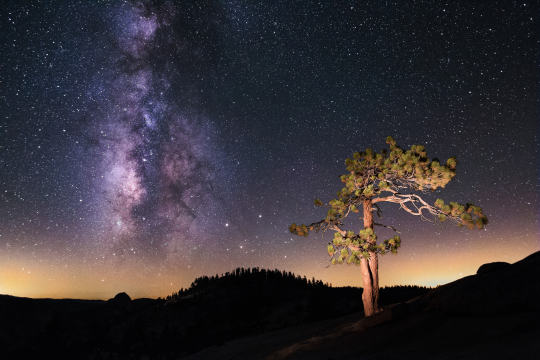
Lone Tree and Milky Way at Olmsted Point by ewoerlen
#500px#Astrophotography#California#Eastern Sierra#Half Dome#Landscape#Milky Way#National Park#Nature
5 notes
·
View notes
Text
Trip to See a Wall
Featuring (in order of appearance):
Akina's Umbrella
The Wall (Playing Itself)
Akina

+ All righty, so we've got a day trip to Tokyo planned, curtesy of Akina. We're going to see the inside of a wall, get our wedding rings polished, find some place for lunch, eat some parfaits, and see a special exhibit at the natural history museum. Let's go! The photo above is leaving the apartment and walking to our nearest subway station.
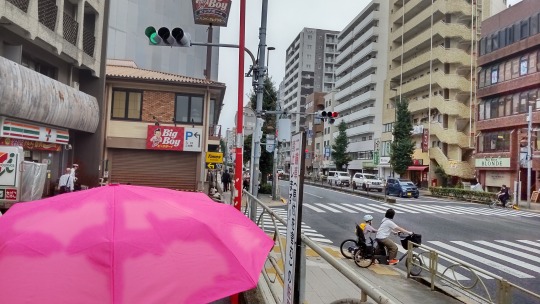
+ Typhoon #13 arrived a couple days ago and today was the trailing end of it, so it was drizzling a bit in the morning. Here is one of the main streets through Wakoshi/Narimasu (our area). Pink umbrella contains the wife.

+ The subway ride takes about 40 minutes to get to very central Tokyo and a transfer; here's that transfer happening, in the guts of Tokyo proper. People here walk noticeably faster than in the North Olmsted of Japan. There's signs here explaining to walk on the left and generally everyone follows them.

+ Back to our old apartment area! Here's standing at the big temple looking east towards Daimon. We're on our way to see the inside of a wall.
+ Okay, so in explanation. Very close to our old apartment is a big, important temple called Zōjōji. I've talked about it a lot; it's where Abe's funeral was, etc.
+ Anyways, back in the day (couple hundred years), the temple grounds were much more extensive than today, but some of the original walls from that time still exist. So a few months ago Akina and I noticed something happening at one of the buildings and stopped by. The idea is that one of these walls needed to be opened up a bit to make room for some modern construction work and it would present the first/only opportunity for people to see the inside of the wall. Thinking it'd be in a few weeks, we signed-up to be notified.
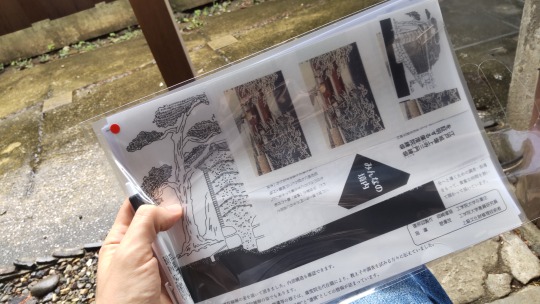
+ That was months ago. We were finally notified and decided to return to make a day trip of it. They give you a big informational packet about this wall and a free can of tea.
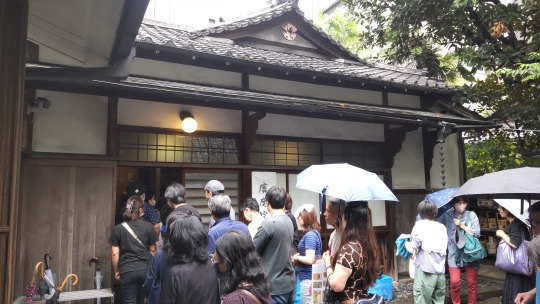
+ So we all crowd into this building...

+ To sit through a one-hour lecture by a professor who knows about walls.
+ I'mma only going to say positive things:
It was good Japanese-listening practice
It reminded me of sitting in a college lecture, something I miss
I was all the way in the back without a chair and it was very comfortable to just relax in the dark for an hour

+ Our mistaken belief was that we'd signed up for the the opportunity to see the inside of the wall. In reality, the wall is just outside, right around the corner. Literally anyone can look at it. Akina's off there on the side demonstrating how she feels about this.
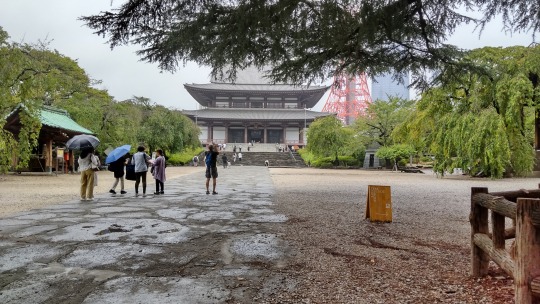
+ Anyways... with that accomplished, we stopped by Zōjōji to see what three months of construction work resulted in. Turns out nothing. They took my rest spot from me for three months for absolutely nothing. Thanks.


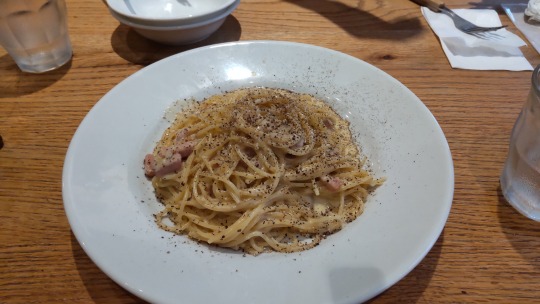
+ Right, so then we dropped off our rings at the wedding ring place and found an Italian lunch place down the street. The pizza was really good; the pasta had way, way too much pepper.
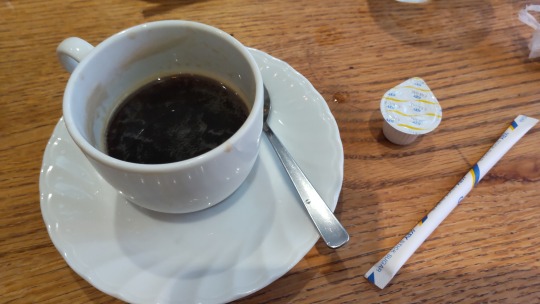

+ Outside lunch is the only time I drink coffee; the one on the left was mine (straight) the one on the right is Akina's after she messed it up by putting cream and all the sugar in, distorting it into something undrinkable, a grotesque distortion of its former self. The photos serve as reference not to do this.

+ Here's Italia Street, where our wedding ring place is located; it's Italian themed
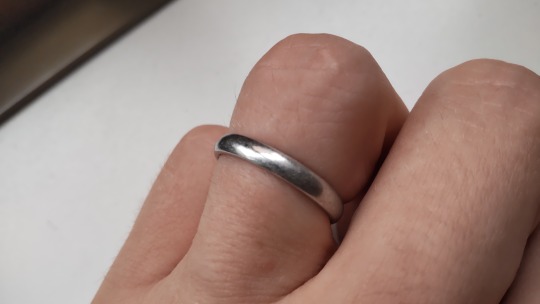

+ And here's the complementary ring polish. Left: before; right: after. Actually, I think that's Akina's hand on the right?

+ So a short subway hop over to Asakusa, a major touristy area filled with shops and famous for a big temple/shrine. Many of the sidewalks are covered like this (with roofs) and there's lots of foreigners.
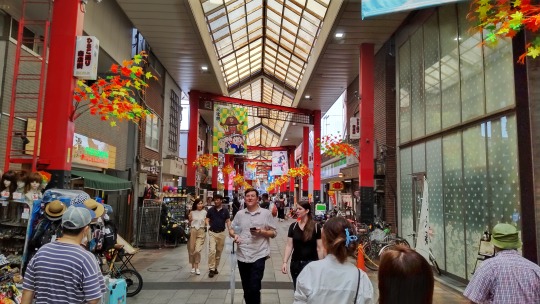
+ But our destination is this covered shopping street. You've seen plenty of these before, they're common.
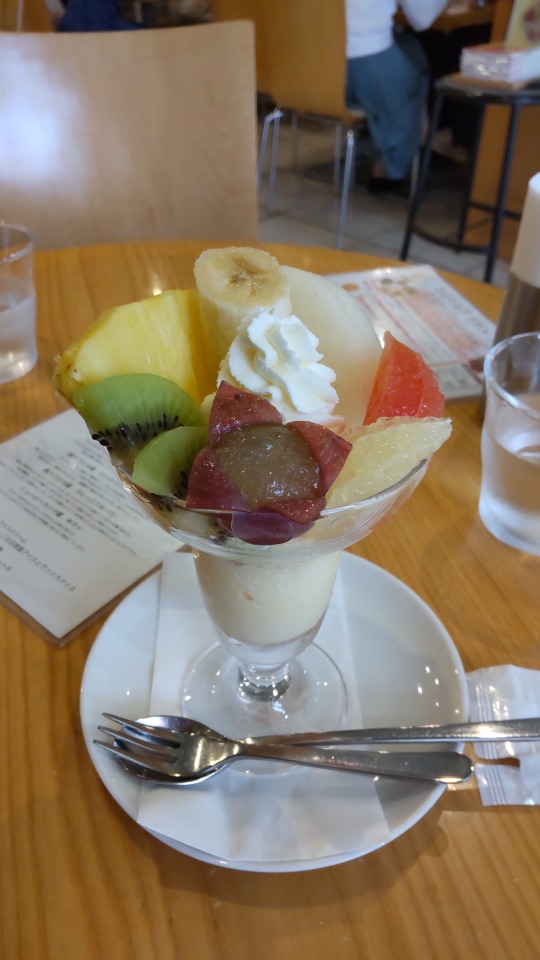
+ Parfait. It wasn't bad, but it wasn't super special. Subtracted points for no crunchy texture inside and no secret waiting in the bottom.
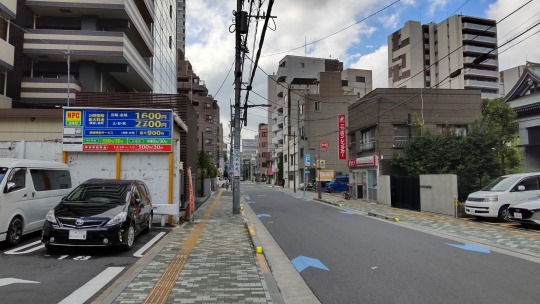
+ With our parfaits eaten, we're walking over to Ueno now to get to the museum. We have a one-year pass to the museum which allows unlimited free visits to the normal rooms, but this time there's a special exhibit. The blue arrows on the road are from recently revised government guidelines dictating road markers for bicycle traffic.
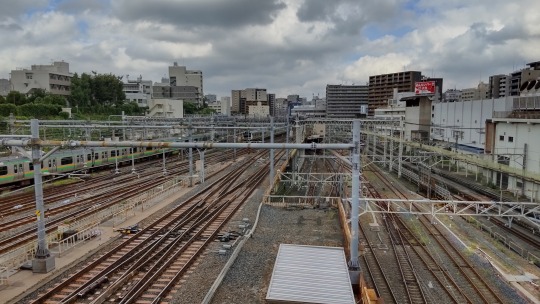
+ Ueno is a major train station so there's lots of train lines here; with that typhoon that just past, today was the first (and only) day in about a month that wasn't over 90°F.
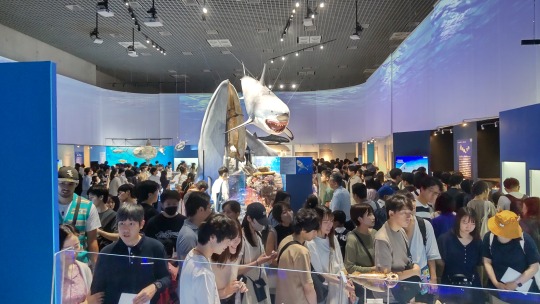
+ The special exhibit was about the ocean. Akina and I have decided these special exhibits are not worth it. On the weekends there's way too many people, but more importantly, we never learn anything from them.
The ocean is really big. Plankton is really small. It's the bottom of the food chain. There's weird things in the ocean. Humans are literally destroying every part of it.
+ Yuup...

+ The museum itself is very large, too much for a single day, so the free pass allows us to spend time checking out things we haven't see before... There's a whole floor on dinosaurs I've never seen...

+ Rocky River! You're world famous!
+ So this (like the hundreds of casts of it around the world), is of specimen CMNH 5768... the largest fossil ever found of Dunkleosteus terrelli, a uniquely Ohio treasure. The first fossils discovered were along the Olentangy River between Columbus and Delaware, but the biggest and most complete come from the Rocky River Valley. The largest of these, CMNH 5768, is in the Cleveland Museum of National History (CMNH), but every replica across the globe (including this one in Tokyo) is of that specimen. In 2020, SB 123 made Dunkleosteus the state fossil of Ohio. I've seen about a dozen or more of these all over.

+ This section also had some of the most ridiculous fossils I've ever seen... This one is perfectly preserved in three dimensions... Who the hell spent the time chipping away at that, without breaking it?
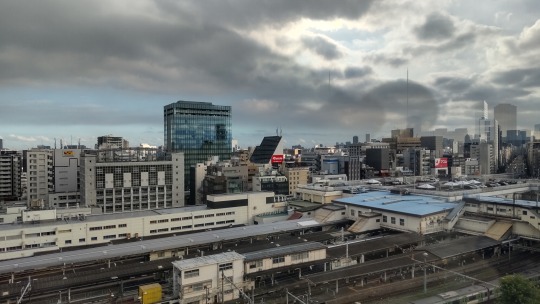
+ The top of the museum has an "herb garden" with only rosemary. There's also an observation deck. This is looking south-east across Ueno.

+ Anyways, that's all for today, making a quick subway transfer in Ginza (you have to walk on the street to transfer, it's weird). You've see this before, it's the fancy shopping district of Tokyo.

+ And we're back... Hope y'all enjoyed.
2 notes
·
View notes
Text
youtube
We Can’t Talk Anymore
It’s called mourning. And we have two different points of view, each right in it’s toxicity to the other. I remember a version of Suzanne Olmsted that I’d like to one day see in a picture book or whatever her Estate decides to grace us with.
Short(ly) after learning of her death, I lashed out on my Instagram. Screaming how I only wanted to hear her voice once more on the pages of a book she wrote about herself.
Do you KNOW what it’s like to follow a hunch and find yourself among the very few to have corresponded with her, shortly before she left? I made a promise from my very spirit not understanding how hard it would be to explain to those who really shouldn’t be involved.
Including myself.
Part of the healing process is the use of journaling, which made this that much more … important to tell correctly.
I AM NOT a Journalist.
I admire them and wanted to meet that standard in my writing. Didn’t seem like much to ask until you learn the human factor. GerryLand is MY expression of a time in my life, we know as lockdown, and how I see the experience as fairly as I know how.
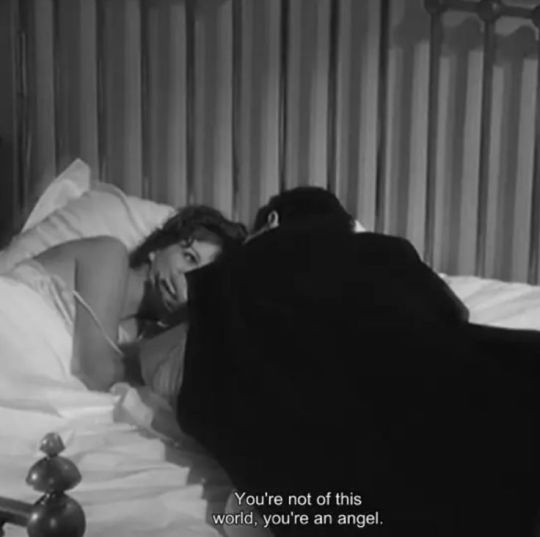
#ethereal#the virgin suicides#girl interrupted#valley of the dolls#esoteric#violets revenge#feminine rage#Youtube
13K notes
·
View notes
Text
The Ultimate Guide to Brookline's Beacon Street: A Historic Corridor Through Time
Beacon Street in Brookline stands as one of Massachusetts' most remarkable thoroughfares, a living timeline that chronicles over a century of American suburban evolution. This storied corridor, stretching from the Boston city line through the heart of Brookline, tells the fascinating story of how a simple streetcar suburb transformed into one of New England's most desirable communities.
From Rural Road to Streetcar Suburb (1800s-1900s)
In the early 19th century, what we now know as Beacon Street was little more than a country road connecting Boston to the rural farmlands of Brookline. The transformation began in earnest during the 1880s when the Metropolitan Railroad Company extended streetcar service along the route. This revolutionary transportation link suddenly made the bucolic countryside accessible to Boston's growing middle class, who sought refuge from the city's increasing industrialization and crowding.
The streetcar era fundamentally reshaped Beacon Street's character. What had been scattered farms and estates quickly gave way to planned residential development designed specifically for commuters. The convenience of the trolley system allowed residents to maintain city jobs while enjoying suburban tranquility, establishing a pattern of suburban living that would define American communities for generations.
Architectural Tapestry: A Century of Design Evolution
Walking along Beacon Street today offers an extraordinary journey through American residential architecture. The streetcar suburb era left its mark in the form of elegant Victorian homes, many featuring the elaborate Queen Anne style popular in the 1890s. These homes, with their distinctive turrets, wraparound porches, and intricate woodwork, reflect the optimism and prosperity of the Gilded Age.
The early 20th century brought Colonial Revival influences, as residents embraced a more restrained aesthetic that celebrated America's architectural heritage. Grand Tudor Revival homes appeared alongside Georgian Revival mansions, creating the eclectic yet harmonious streetscape that defines much of Beacon Street today.
Perhaps most significant are the apartment buildings that began appearing in the 1920s and 1930s. These structures, ranging from modest three-deckers to elegant Art Deco complexes, represent Brookline's evolution from an exclusive suburb to a more diverse community. Buildings like the iconic Beacon Street apartment blocks near Cleveland Circle showcase the sophisticated urban planning that made higher-density living both practical and desirable.
Notable Residents and Cultural Legacy
Beacon Street has long attracted accomplished residents who have shaped American culture, politics, and intellectual life. The street's proximity to both Boston's cultural institutions and its own excellent schools made it particularly appealing to professors, writers, and professionals.
During the early 20th century, many Boston Symphony Orchestra musicians made their homes along Beacon Street, drawn by the combination of suburban quiet and easy access to Symphony Hall. The academic community from nearby Boston University also established a strong presence, contributing to the intellectual atmosphere that continues to characterize the neighborhood.
The street has been home to numerous authors, journalists, and artists who found inspiration in its tree-lined tranquility while maintaining connections to Boston's vibrant cultural scene. This tradition continues today, with Beacon Street remaining a preferred address for creative professionals and academics.
Landmarks and Points of Interest
Several significant landmarks punctuate Beacon Street's length, each telling part of the broader story of Brookline's development. The Frederick Law Olmsted Historic Site, while not directly on Beacon Street, influences the area's character through Olmsted's vision of integrated parks and residential areas that shaped much of Brookline's planning philosophy.
The variety of religious institutions along Beacon Street reflects the community's diverse heritage. Historic churches representing various denominations stand as testaments to the area's role as a welcoming community for different immigrant groups throughout the 20th century.
Local businesses have evolved alongside residential development. What began as small shops serving streetcar commuters has grown into a sophisticated commercial corridor featuring everything from family-owned restaurants that have served multiple generations to contemporary cafes and boutiques that attract visitors from across the Boston area.
The Streetcar Legacy and Transportation Evolution
The original trolley system that sparked Beacon Street's development operated until the mid-20th century, leaving an indelible mark on the area's urban form. The wide street design, originally accommodated streetcar tracks, now provides space for parking and bicycle lanes that make the corridor pedestrian and cyclist-friendly.
Today's MBTA Green Line continues this public transportation tradition, connecting Beacon Street residents to downtown Boston and beyond. The accessibility provided by public transit remains one of the area's most attractive features, allowing residents to enjoy suburban amenities while maintaining easy access to urban employment and cultural opportunities.
Evolution into a Modern Family Destination
The transformation from streetcar suburb to contemporary family neighborhood represents one of Beacon Street's most remarkable achievements. The area has successfully adapted to changing demographics and lifestyle preferences while maintaining its essential character.
Modern families are drawn to Beacon Street for many of the same reasons that attracted the original streetcar commuters: excellent schools, safe neighborhoods, and convenient access to Boston. However, today's residents also value the area's walkability, environmental consciousness, and cultural diversity.
The presence of numerous parks and playgrounds along or near Beacon Street makes it particularly attractive to families with children. The combination of urban amenities and suburban space provides an ideal environment for raising families, contributing to the area's reputation as one of Greater Boston's premier residential neighborhoods.
Commercial Evolution and Local Business
Beacon Street's commercial development reflects broader changes in American retail and dining. Early streetcar-era businesses focused on daily necessities for commuting residents. Over time, the commercial corridor has evolved to include restaurants, specialty shops, and services that serve both local residents and visitors from throughout the Boston area.
The dining scene along Beacon Street tells its own story of cultural evolution. Family-owned restaurants that have operated for decades alongside newer establishments that reflect changing tastes and demographics. This blend of established and emerging businesses creates a dynamic commercial environment that serves diverse community needs.
Preservation and Future Development
Balancing historic preservation with contemporary needs remains an ongoing challenge along Beacon Street. The community has generally succeeded in maintaining the architectural character that makes the street distinctive while allowing for appropriate modernization and new development.
Recent years have seen thoughtful additions to the streetscape, including improved pedestrian infrastructure, bicycle accommodations, and carefully designed new residential and commercial buildings that complement the existing architectural fabric. This approach to development reflects a mature understanding of how to honor the past while meeting present and future needs.
Living History: Beacon Street Today
Today's Beacon Street represents the successful evolution of the American streetcar suburb concept. The foundational elements that made the area attractive over a century ago – convenient transportation, quality housing, good schools, and community amenities – remain central to its appeal.
The street serves as a living laboratory for sustainable suburban development, demonstrating how historic neighborhoods can adapt to contemporary needs while maintaining their essential character. The combination of architectural diversity, cultural richness, and practical amenities makes Beacon Street a model for thoughtful community development.
Contemporary residents enjoy many advantages that the original streetcar commuters could hardly have imagined: sophisticated restaurants, diverse cultural programming, excellent public services, and a strong sense of community that spans generations. Yet the fundamental appeal remains unchanged – a place where urban convenience meets suburban quality of life.
Conclusion: A Corridor for All Seasons
Beacon Street's journey from rural road to streetcar suburb to contemporary family destination illustrates the best of American community development. The street's success lies not in resistance to change, but in thoughtful adaptation that honors the past while embracing the future.
As Brookline continues to evolve, Beacon Street remains a constant – a beautiful, functional, and welcoming corridor that connects past and present while pointing toward a future that builds on the community's greatest strengths. For residents, visitors, and students of urban development alike, Beacon Street offers lessons in how communities can successfully navigate change while maintaining the qualities that make them special.
Whether you're walking along its tree-lined sidewalks, dining at one of its many restaurants, or simply appreciating the architectural diversity that reflects over a century of American life, Beacon Street continues to reward exploration and contemplation. It stands as proof that the best communities are those that honor their history while remaining open to the future.
Visit: https://gonnellapainting.com/
1 note
·
View note